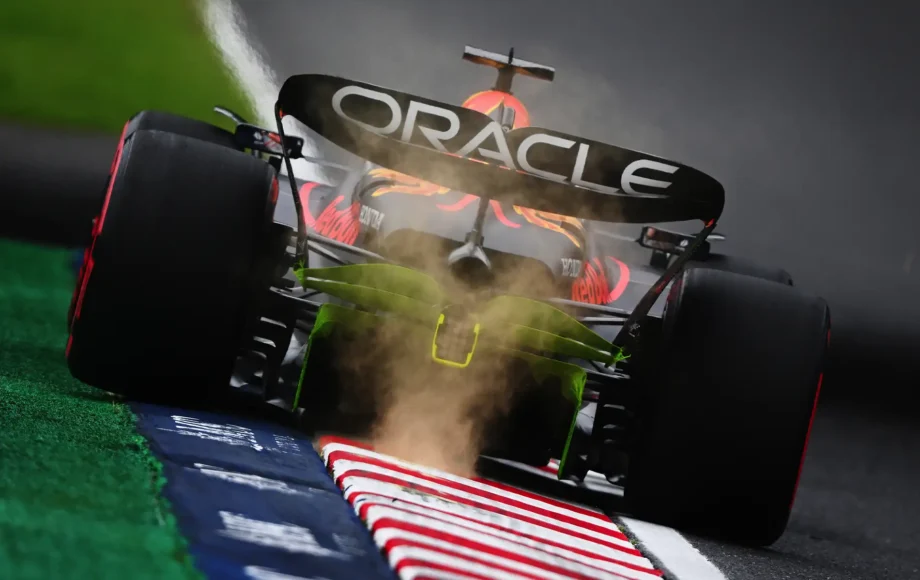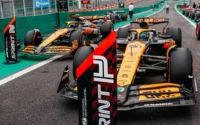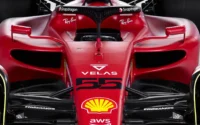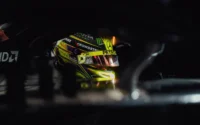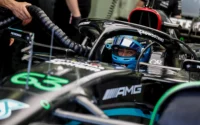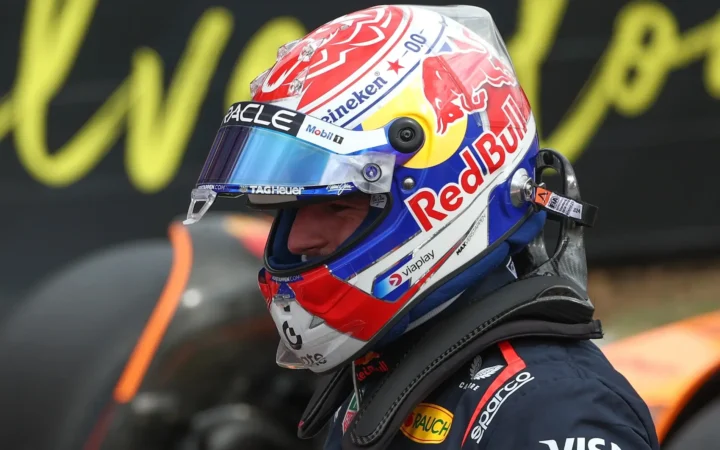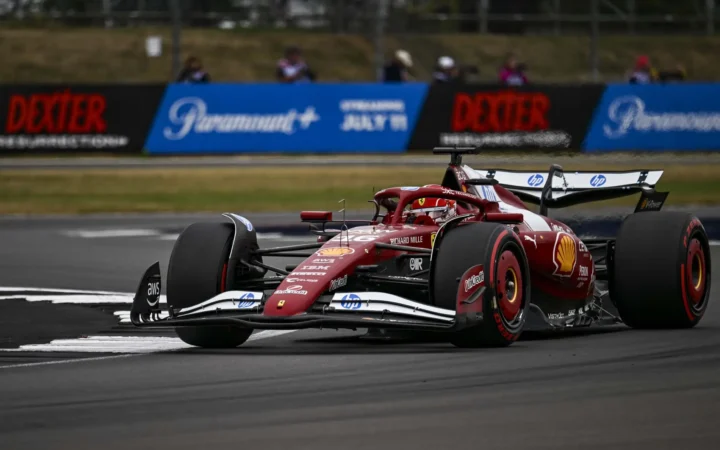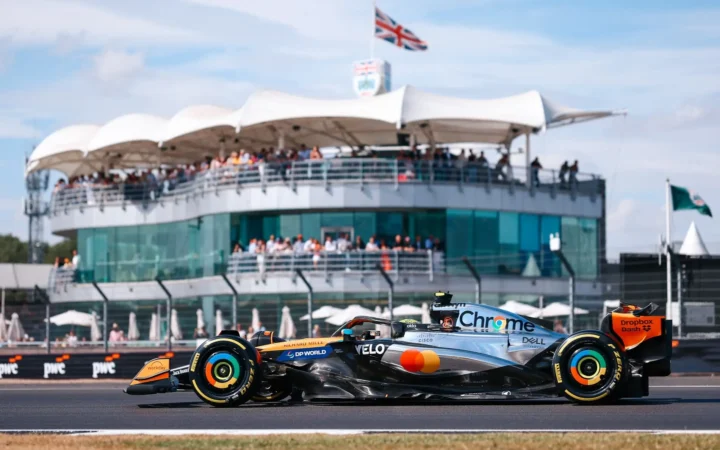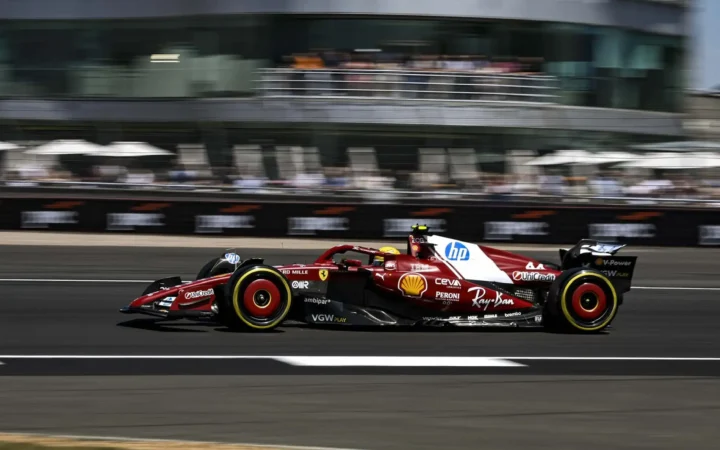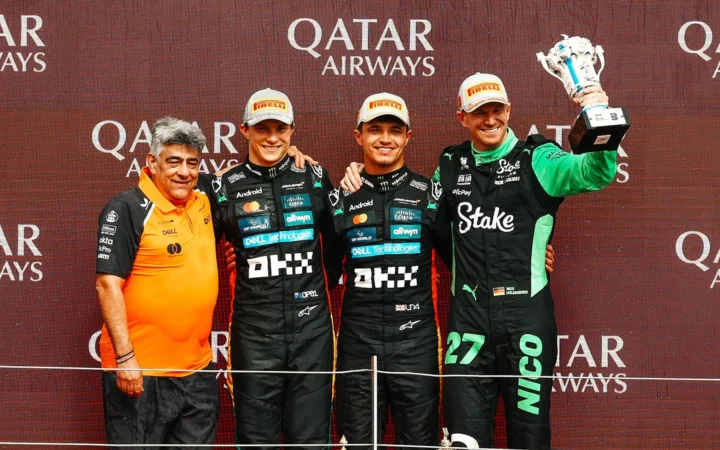DRS, or the Drag Reduction System, is featured on the rear wing of an F1 car and has helped reshape the sport for over a decade, playing a pivotal role in the outcome of qualifying, races, and even the championship.
What to know
- The Drag Reduction System was first introduced in Formula 1 during the 2011 season.
- The primary purpose of the Drag Reduction System is to improve overtaking opportunities during Formula 1 races.
- F1 drivers activate DRS with the press of a steering wheel button.
- 2025 would be the final season of DRS. From 2026, the sport would adopt cars with active aerodynamics and movable wings.
So, what does DRS mean, and how does it work? In this guide, we delve into the history, function, and future of DRS in F1.
The history and introduction of DRS in F1
The Drag Reduction System (DRS) was first introduced in Formula 1 during the 2011 season. The concept behind DRS was simple: create a system that allowed drivers to adjust the aerodynamics of their car’s rear wing to reduce drag and increase straight-line speed. Opening a flap in the rear wing, DRS helps drivers to overtake and makes races more exciting for fans when a car runs within one second of the car ahead. Drivers can also activate this system during practice and qualifying laps, even when they are on the track alone.
More on F1 Qualifying
As F1 teams continue to innovate, this also causes issues with how much turbulent air comes off the rear of an F1 car. Too much turbulent air makes it difficult for the following car to overtake. DRS aimed to level the playing field, reducing aerodynamic drag and increasing straight-line speed to encourage more daring overtakes.
However, DRS isn’t without its critics, who argue that it artificially allows drivers to gain an advantage by pressing a simple button to boost speed, detracting from the skill and challenge of overtaking.
But DRS is more than a simple overtake button that guarantees passing the car in front. While there have been, and are still, instances where it seems too powerful, DRS does lead to passes well before braking zones, so its primary purpose is to assist in overtaking when drivers would otherwise struggle in the turbulent air caused by the leading car.
The latest generation of F1 cars, introduced in 2022, were designed to reduce the “dirty air” effect even further to allow closer following and overtakes even without DRS. The “dirty air” effect refers to air already disturbed by one car being directed onto the front of a car following closely behind. This results in unpredictable handling and increased tyre wear due to the trailing car sliding more.
The 2022 rule changes have generally been effective; they have reduced the slipstream effect, but as the seasons progress, teams are pushing the boundaries of this, and dirty air is making a resurgence in F1. And, with an engine freeze, until rule changes for the 2026 F1 World Championship, DRS still holds sway in overtaking manoeuvres.
Why was DRS introduced in 2011?
Before introducing the Drag Reduction System (DRS), drivers found it extremely hard to overtake. Instances of this can be traced back to as late as the final race of the 2010 Formula 1 season finale, the final race before DRS was introduced the following year.
During the Abu Dhabi Grand Prix, Fernando Alonso encountered a significant challenge. He found himself stuck behind Renault driver Vitaly Petrov for a considerable portion of the race. This unfortunate situation ultimately proved to be a decisive factor in costing Alonso the driver’s championship, which ultimately went to Sebastian Vettel.
This particular race magnified the broader issue in Formula 1 at the time of turbulent air, making it difficult for drivers to follow other cars on the track closely; hence, the introduction of DRS was a response to these challenges. Without the aid of DRS, the sport could have potentially witnessed a scarcity of overtaking manoeuvres and fans abandoning the sport.
What is DRS and how does it work?
The Drag Reduction System is a mechanism integrated into the rear wing of an F1 car, designed to optimise aerodynamics and increase straight-line speed. This system uses an actuator in the middle of the car’s read wing to control a flap. The driver can open this flap by pressing a button on the steering wheel, but only when they enter designated sections of the track referred to as DRS ‘Activation’ zones. When the flap opens, it reduces the surface area of the rear wing, effectively decreasing aerodynamic drag and leading to between 15kph and 30kph extra top-end speed.
During a race, the DRS can be activated when an F1 Driver runs within one second of the car in front, even if that car is being lapped. DRS usage is allowed in practice and qualifying sessions but is restricted to specific activation zones. Before 2013, drivers had the freedom to use DRS anywhere on the track during qualifying, which led to Formula One Teams configuring their setups for optimal performance in qualifying but hindered wheel-to-wheel racing during the actual races.
The crucial one-second gap between cars is determined at predefined points before entering a DRS zone, known as the ‘detection’ point. Electronic timing loops around the track measure the distance between the two cars. If the following car is found to be less than one second behind at this detection point, a signal is transmitted to allow activation for the upcoming DRS zone.
Drivers are typically alerted to the availability of DRS through a digital display or illuminated lights on their steering wheels. For the car in front, the team often communicates the presence of a rival within the one-second gap. Depending on driver preference, the attacking driver can activate DRS by pressing a designated steering wheel button, which may be positioned on the front or back of the steering wheel.
When an F1 driver runs with DRS active and the rear wing open, they can deactivate DRS by lifting off the accelerator or applying the brake pedal. The steering wheel button also closes the rear wing flap if pressed a second time. Drivers may close the wing before entering a corner if they are concerned about aerodynamic stability upon entry.
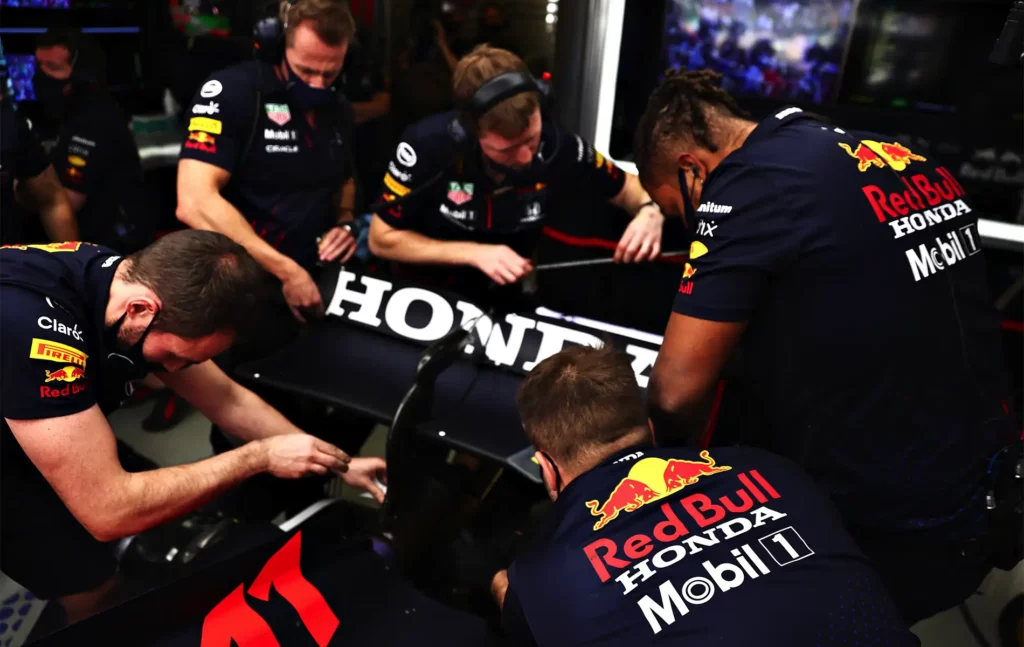
It’s important to note that drivers are not obligated to activate DRS if they are running within one second of another car, and pressing the button too early can result in a delay before the wing opens at the desired point.
DRS usage is restricted in specific situations. Initially, it could not be used within the first two laps of a race or after standing or rolling restarts following a safety car or red flag period. For the 2024 season, drivers will be allowed to use their DRS after just one lap, provided they drive within a second of the car ahead. This rule also applies to a period behind a safety car.
Additionally, race officials have the authority to disable DRS if conditions are deemed unsafe, such as during rain or when track debris poses a hazard in a particular zone.
Defending drivers can activate DRS only if they are within one second of a car in front. This often leads to a term known as a ‘DRS train,’ where multiple cars in close proximity neutralise the DRS advantage, maintaining relatively stable gaps. In response, defending drivers may use their electrical energy reserves charged via the hybrid elements in modern F1 powertrains, commonly called the ‘overtake’ button or ‘SoC’ (state of charge) button. This extra boost in power aims to give drivers a defensive chance against a pursuing car with DRS activated.
How many DRS zones are there?
The number of DRS zones varies from one track to another, depending on the circuit’s specific layout. The FIA determines the placement of the DRS zones before each race weekend.
For instance, Bahrain features three DRS zones, whereas Monaco, with its unique and tight layout, has just one.
Notably, the FIA avoids positioning DRS zones on corners for safety reasons. However, they have trialled this in the past at several race weekends. Although it’s unlikely that we will witness a DRS zone within the Monaco tunnel or similar high-risk areas.
An illustrative instance of the dangers of allowing DRS zones on corners occurred during the 2018 British Grand Prix when a third DRS zone was introduced, extending down the Silverstone pit straight and through the high-speed opening two corners. However, this change led to two significant accidents at the first corner (Abbey) involving Romain Grosjean and Marcus Ericsson during practice and race sessions. Unsurprisingly, in 2019, that particular DRS zone was removed and has not been seen at Silverstone since.
The benefits of DRS
The primary purpose of the Drag Reduction System is to improve overtaking opportunities during Formula 1 races and boost the spectacle of a race weekend. The key benefits of DRS since its introduction include:
- Enhanced Overtaking: DRS has undeniably increased overtaking manoeuvres during races, making Formula 1 more exciting for fans.
- Strategy and Tactics: DRS adds an element of strategy to races. Drivers must decide when and where to use DRS to maximize their advantage while considering their tyre wear, fuel levels, and competitors’ position.
- Reduced Monotony: DRS helps reduce the perception of monotony in Formula 1 by creating more dynamic and thrilling races.
- Spectator Engagement: DRS has contributed to increased fan engagement, often resulting in intense battles for position.
DRS failures
The potential for a DRS malfunction where the wing remains open can result in drivers receiving a black flag with an orange circle.
In such an event, the driver must return to the pits. There, the car’s mechanics will manually close the stuck DRS flap. If the issue can’t be fixed, the driver won’t be allowed to use DRS for the remainder of the race.
A notable incident illustrating the consequences of a DRS failure unfolded during the 2018 Italian Grand Prix. At Monza’s first chicane, Marcus Ericsson experienced a severe accident in his Sauber when the flap in his rear wing failed to close when he applied the brakes at high speed.
What other racing series uses DRS?
DRS is commonly associated with Formula 1. However, other motorsport series have also explored the concept of adjustable aerodynamics to reduce drag and increase speed.
DRS finds itself beyond the F1 grid and has entered supporting categories like Formula 2 and Formula 3.
DRS debuted in Formula 3 in 2017, when the series was still called GP3. Initially, drivers were limited to activating and using the system for a maximum of six laps in feature races and four laps during sprint events. However, since 2019, Formula 3 has aligned its DRS rules with those of Formula 1, ensuring consistency in the sport. In Formula 2, formerly GP2, DRS has been used since 2015.
DRS has also been featured in other motorsport series. For instance, the DTM (Deutsche Tourenwagen Masters), a German touring car series. DTM has used adjustable aerodynamics, such as in Formula 1, to enhance overtaking. However, since 2021, DTM has transitioned to GT3 regulations, so it no longer features DRS.
While Formula E, an all-electric single-seater motorsport series, doesn’t use DRS technology, it does have a concept known as “Attack Mode.” In attack mode, drivers can activate a special power boost by driving through a designated activation zone off the racing line. This adds an element of strategy and overtaking opportunities to Formula E races, similar to DRS in Formula 1.
Various other motorsport series employ overtaking aids similar to Formula E to enhance the racing spectacle. These aids typically boost engine performance temporarily for a specified duration during each race. For example, IndyCar utilises a “push-to-pass” system, while Super Formula incorporates the “Overtake System.”
2026: The end of DRS in F1
As Formula 1 continues to evolve, the future of DRS remained an intriguing topic of discussion. While DRS undeniably enhanced overtaking opportunities and excitement in races, it has also faced criticism for potentially making overtaking too easy and artificial.
The future of DRS hung in the balance for some years with talk of refining the system to strike a balance between maintaining the challenge of overtaking and ensuring fair competition. Formula 1’s governing body, the Fédération Internationale de l’Automobile (FIA), constantly reviews and modifies DRS regulations to achieve this balance. Changes included adjusting DRS zones, reducing the angle of the movable wing, and implementing DRS usage limits.
Also, the development and changes to hybrid and electric powertrains in Formula 1 would influence the role of DRS. As cars became more energy-efficient and sustainable, the need for DRS during overtaking diminished so much that as the 2025 Formula 1 season began, it became the final year for the power unit configuration that debuted in 2014. A new configuration would be introduced in 2026, eliminating the MGU-H but enhancing the MGU-K’s power output. 2025 would also see the last car generation introduced in 2022 and the final season for the drag reduction system (DRS), first implemented in 2011 as an overtaking aid. From 2026, the sport would adopt cars with active aerodynamics and movable wings.
With F1 ditching the current Drag Reduction System (DRS) in favor of active aerodynamics—movable front and rear wings designed to boost overtaking and on-track excitement- drivers will have two aerodynamic modes at their disposal:
- Z-Mode (Cornering Mastery): Adjusts wing angles for higher downforce and improved grip through corners.
- X-Mode (Top Speed): Flattens the wings to reduce drag, maximizing speed on straights.
While drivers will control when to switch modes, usage will be restricted to FIA-approved safe zones, typically long straights lasting over three seconds. This shift places a greater emphasis on driver skill and strategy, ushering in a new era in which overtaking becomes a more tactical, calculated art.
Frequently asked questions
Can a race leader use DRS?
Yes, so long as the race leader is within one second of the car in front of them and there is a designated DRS activation zone on the track. In most cases, a race leader does not have the opportunity to use DRS, as they are leading the race without a car directly in front of them within the one-second gap.
How much faster are you with DRS?
The speed advantage gained from using DRS in Formula 1 can vary for car design, track surfaces and conditions, and the length of the DRS zone.
Generally, when a driver deploys DRS in a designated zone, it can provide a speed boost of approximately around 15 kilometres per hour (6 to 9 miles per hour) compared to running without DRS. However, Red Bull’s 2023 and 2024 challengers have seen speed differences of over 30kph. This speed increase can be significant on straights and is intended to aid in overtaking by allowing the pursuing car to close the gap to the car in front and attempt an overtake.
However, the actual speed advantage may vary from track to track and between different cars, as it depends on the aerodynamic characteristics of the cars and the length of the DRS zone. Some tracks have longer DRS zones, where the effect can be enhanced, while others have shorter zones where the speed gain may be less significant.
How does a driver know if they can use DRS?
In Formula 1, drivers are informed whether they can use DRS through several means:
Dashboard Display: Modern Formula 1 steering wheels feature a display that provides real-time information to the driver. This display will typically indicate whether DRS is enabled or disabled. A “DRS” or similar indicator will light up if it’s available.
Team Communication: The driver’s team will communicate with them over the team radio to inform them when DRS is enabled and when it’s not.
To activate DRS, a driver must be within one second of the car in front of them when they cross a designated DRS detection point on the track. Timing systems and data analysis provide this information to the driver and their team.
What is the flashing red light on F1 cars?
The red flashing light positioned at the rear of an F1 car has two primary purposes: it enhances visibility in adverse weather conditions and signals the vehicle’s Energy Recovery System (ERS).
Since its introduction in 2014, this red light has indicated to the following drivers and fans that the ERS is actively recovering energy. In addition, in heavy rain, the red flashing light on the rear of the car addresses visibility issues and makes the car more visible. Unlike road cars, F1 drivers do not have the luxury of windscreen wipers.
Seen in:

